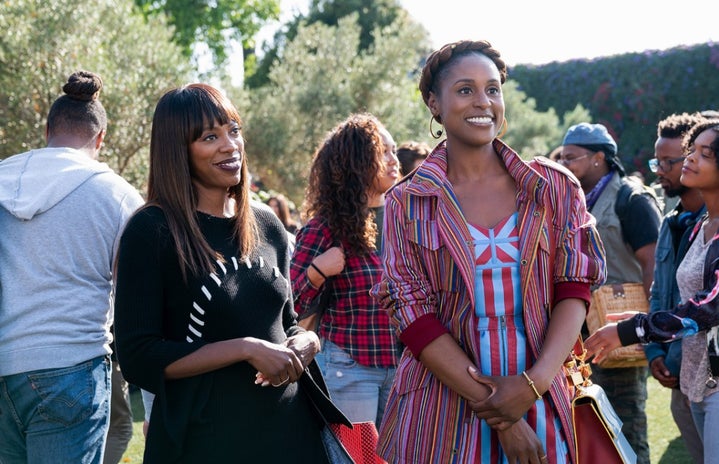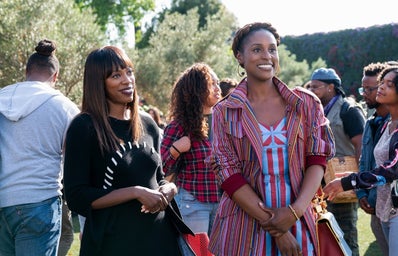If you thought that being a lost and panic-driven woman in my twenties would be enough to discourage me from watching other (fictional) women grapple with the same issues I have to endure, you thought wrong.
I’ve always loved coming-of-age content, be it movies, songs, or television shows. I found comfort in watching others navigate life like a bird flying with a broken wing. Maybe the reason is simple: maybe it’s because I see myself reflected in such characters. But, as a self-professed connoisseur of coming-of-age media, I’ve noticed something— the girl-group, twenty/thirty-something, getting-your-life-together is a shit-show shows are evolving.
We cannot discuss the girl-group genre without starting with Sex and the City (1998). The show is a cult classic for obvious reasons. It radiates comfort for young female audiences, forced to endure the tumultuous terrain of a bleak dating scene—a reality that has, unfortunately, not changed much since the 90s. Being disappointed by the men who leave our lives just as casually as they entered is a never-ending rite of passage for the modern woman.
But by making romance and sex (be it a raging success or a huge flop) the main focus of the show, it distracts from the many experiences and internal struggles that the characters face apart from dating. One could argue that this is the point of the show (it is, after all, called “Sex and the City” for a reason). Yet, at times I found myself disappointed by the way male love interests dominated the plot.
Ironically, Miranda had this epiphany in one episode, asking the others, “how does it happen that four such smart women have nothing to talk about but boyfriends?” Miranda’s plea, “does it always have to be about them,” resonated with me. I have often been angry at myself for wasting my time talking or thinking about a guy, when I know full well the infinite amount of other interesting topics my miraculous thing called a mind could be used for.
But, as the episode progresses, Miranda sees an ex on the busy streets of New York with another woman. Objecting from boy-talk is easier said than done. I loved how this episode captured the internal desire to push back against the way men often dominate topics of conversation in girl groups, and the difficulty in doing so. Yet, the show itself continued with plot lines dedicated solely to dating. I don’t know if I can blame the SATC writers though, after all the show is supposed to be about dating.
But still, I felt there was more to be desired.
Cue: Lena Dunham’s Girls (2012). Dunham is a controversial character in Hollywood, and rightly so. Often, I find myself not wanting to admit that I actually really enjoyed Girls. I liked that Dunham’s character, Hannah, wasn’t perfect. She often lacked self-awareness, was obnoxious, and acted entitled. Most importantly, the show’s writing felt honest. It highlighted the complexity and stress present in all forms of relationships—with lovers, friends, parents. Much like my own life, friendships in your twenties can waver and wane. One of my favourite moments on the show is when Hannah and Marnie’s friendship begins to crack under the weight of insecurity and resentment. The episode ends with the girls in a screaming match, shouting, “I’m not the wound, you’re the wound!” The hurt and anger between the two characters illustrates that friendships between girls are often intense, emotionally tolling, and sometimes toxic. The show also depicts what it feels like to be lost in your professional life, directionless, and essentially floating. Unlike SATC, Girls depicted love and dating on the show, but the show wasn’t about love and dating. Put simply, it was about the girls. I appreciated that.
Girls did, however, lack something important. In her essay, “Girls, Girls, Girls,” Roxane Gay points out that shows like Girls consistently lack representation for women of colour. Although, Gay points out that Dunham alone cannot be blamed or held solely responsible for a reoccurring problem in mainstream television—one which consistently fails to include the complex inner worlds of racially and culturally diverse characters. Gay writes that, “the absence of race in Girls is an uncomfortable reminder of how many people lead lives segregated by race and class.” Truly, Dunham’s creation not only features an all-white class, but it seldom references race at all.
Girls is undoubtedly written by and for a certain demographic—one that not every twenty-something girl will relate to. Since Gay’s essay, written in 2012, shows like High Fidelity (2020) and Insecure (2016) have emerged. I binged Issa Rae’s Insecure this summer. It felt like a show Gay wanted to see on tv when she wrote “Girls, Girls, Girls”—one which had a Black character front and centre, and explored her experiences stumbling through life with complexity and nuance. Insecure does what Girls didn’t, or couldn’t do—given its lack of diversity, from the cast to the writer’s room.
In contrast to Girls and SATC, Insecure tackles issues like race, gender, and class in interesting and thought-provoking ways that go beyond the surface. The show explores racism as something that happens within and between different cultures. It also brings in conversations on gentrification, being confronted with Black stereotypes, as well as code-switching and the difficulty in working alongside white coworkers. It does this, while also bringing in imperfect characters who are constantly fumbling in their personal lives. Like Girls, this means friendship break-ups due to the characters’ own insecurities, like jealousy and defensiveness between Issa and her best friend, Molly. Moreover, the show features infidelity, betrayal, being evicted, being forced to sleep on an ex’s couch, and, finally, having to pick yourself back up. The characters Rae creates are messy, like Dunham’s, but they’re also more likeable. The show somehow tackles harder topics, without being as cynical or bleak as Girls.
The twenty/thirty something girl-group has come a long way since Sex and the City, and each of these three shows mark the passage of time for young women in mainstream television. How girls are represented, how our lives are portrayed, and which girls get airtime is changing, and it’s making room for more developed, more complex, and more diverse characters. The final season of Issa Rae’s Insecure is out now on HBO and Crave. Although fans of the show are sad to see it end, Insecure’s success is a reminder that there’s still so many stories waiting to be told.

